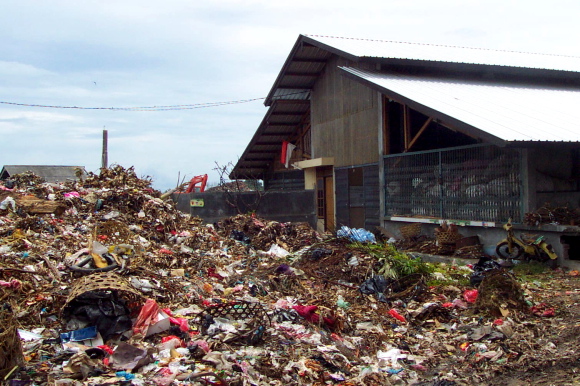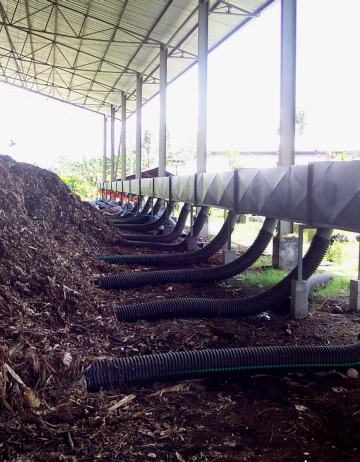Tessa Toumbourou
Biomass is aerated on-site to ensure aerobic compostingImage courtesy of myclimate |
The United Nation’s Clean Development Mechanism (CDM) is a way for companies, banks and governments in industrialised countries to invest in projects located in developing nations such as Indonesia, that promise to reduce net carbon emissions to the atmosphere. Yet the United Nations is approving Indonesia-based carbon offset projects that do not meet any of Indonesia’s own sustainable development criteria, including requirements for open consultation with local communities. There is also debate over whether many of the approved projects will actually reduce carbon emissions, much less deliver on promises of sustainable development for Indonesia.
Under the CDM, a central part of the Kyoto Protocol, carbon emission reduction projects are approved based on UN standards and on sustainable development criteria set by the host country. Emission reduction credits from approved CDM projects registered with the UN may then be sold in the emerging global carbon trade market. The CDM works by providing developed countries with a cheap alternative to reducing their own greenhouse gas emissions. It promotes cost-effective carbon reductions through projects located in developing countries while allowing developed countries to continue business-as-usual. This process, called ‘offsetting’, is the only aspect of the Kyoto Protocol that formally links developing countries to the international climate change treaty. The CDM has the secondary objective of promoting sustainable development in host countries by both boosting local livelihoods and environmental factors while reducing emissions. Yet while the CDM has created the world’s largest carbon offset market, it has made little contribution to sustainable development.
More than lip-service?
Indonesia now hosts 48 carbon trade projects registered with the CDM, a number that has doubled in the past year. Over a hundred more projects in Indonesia are in the pipeline awaiting UN approval. After four years of CDM projects approved in Indonesia, it is increasingly evident that the Kyoto Protocol’s promise of sustainable development for Indonesia is not being met and simply favours cheap emission reduction projects over those more likely to deliver social or environmental benefits.
Only projects registered by the UN may be used to sell or use emission reduction credits on the international emission offset market. The UN requires that anyone seeking to implement a CDM project for tradable carbon credits must submit a project design document to show that the project meets all legal requirements, including the host country’s own sustainable development criteria. Registration by the UN also requires a letter from the host country’s CDM authority stating that the project meets national sustainable development criteria.
Indonesia’s sustainable development criteria are more comprehensive than those of most host countries, encompassing environmental, social and economic dimensions as well as technology transfer. However, these criteria are framed in terms of doing no harm, rather than in terms of contributing positively to Indonesia’s development goals. For example, the economic aspect of the criteria requires only that a CDM project ‘not lower a local community’s welfare’ but does not require the improvement of community living standards.
The negative wording of these criteria creates loopholes that allow projects to be approved that make no real contribution to sustainable development. Project developers manipulate this negative language to suit their commercial priorities, often to the detriment of broader sustainable development outcomes. For example, one agribusiness project developer, AES AgriVerde based in Bermuda, has had eight projects approved to recover methane from tapioca processing factories located in Sumatra. All eight project design documents describe identical sustainable development contributions and an identical stakeholder consultation process. This despite the fact that it is highly unlikely that eight different projects in eight separate locations would each achieve the same single sustainable development outcome if each local community had actually been consulted. This kind of redundancy suggests not merely a cost effective approach to project design, but rather the possibility of fraud, allowing AES AgriVerde to sell carbon credits for eight projects while producing only one predicted sustainable development outcome.
No accountability
Indonesia requires project developers to conduct an environmental impact analysis and provide evidence of public consultation with local stakeholders for each project to ensure that the local community will be informed and willing participants. But these requirements for stakeholder consultation on CDM projects are either taken lightly or simply ignored. Actual CDM project approval by Indonesian and UN authorities is based only on project developers’ own reports, with no independent or third party assessment. As a result, few Indonesian CDM projects actually meet Indonesia’s sustainable development criteria, thus allowing development banks and companies to use the same CDM project design and sustainable development evaluation document for multiple projects in order to fast-track UN approval and registration.
Where project design documents do address public concerns, community members often question whether the project will increase employment or improve living standards. Few project design documents consider potential adverse impacts on local industries and resources from, for example, bringing migrant workers and technology to the area, or even whether there are other local priorities that CDM investment could meet. So despite having a verification system for stakeholder consultation, few projects properly meet the criteria to provide sustainable development benefits for the communities where they are located. Instead, it appears that approved CDM projects are generating large sums for project developers and allowing developed countries to continue polluting, while compromising Indonesia’s own real emission reduction opportunities.
 |
Before the CDM project, waste piled up in front of the pilot siteImage courtesy of myclimate |
One example of this is the Prototype Carbon Fund, a World Bank initiative, that operates two carbon offset projects claiming credits from three Indonesian cement factories located in Citeureup and Cirebon in West Java and South Tarjun in Kalimantan. The two carbon offset projects’ CDM design documents only briefly mention the environmental and technology transfer aspects required to meet Indonesia’s sustainable development criteria. Neither project proposal mentions any social or economic benefit beyond possibly increasing employment. A single stakeholder consultation meeting purports to cover both projects, with no information about the process used to identify and involve stakeholders beyond advertising in local papers, and noting that the project had been ‘communicated and disclosed to the central government, and regional governments’. Both project documents state that ‘no objections or comments [were] received’ following the stakeholder consultation.
This case reflects a wider trend, where stakeholder consultations required for CDM project approval, as reported in many banks’ and companies’ project design documents, are open only to participants invited by project proponents – a practice that stifles critical views or alternative suggestions. Some CDM projects have been approved without any stakeholder consultation at all. And while the project design documents are posted on the internet for public scrutiny before their final approval by the UN, few people who may be adversely affected by most CDM projects have internet access, severely restricting their ability to comment or raise concerns.
A different path
CDM proponents can point to a few Indonesian CDM sustainable development successes. Two NGO-run CDM projects do meet all four of Indonesia’s sustainable development criteria: environmental, social, economic benefit and technology transfer. They also involved stakeholder consultation advertised in accessible public media and held in neutral locations open to all local community members. Both of these projects are driven by niche European carbon credit ‘buyers’ willing to pay a premium price for the resulting CDM carbon credits.
The first of these projects, run by Klimaschutz, provides solar cookers to communities in Aceh, replacing indoor fires. By reducing dependence on wood for cooking, solar cookers help reduce reliance on forests for firewood, save time spent gathering firewood or money spent paying for fuel, and reduce exposure to indoor smoke. The project depends on communities’ active participation to ensure that their members actually use solar cookers instead of wood or fossil fuels. The second project, operated by MyClimate, involves waste recovery by trapping methane, a potent greenhouse gas, from a Balinese village landfill site, and paying local participants to sort and divert waste into compostables or recyclables. This project has created jobs for villagers who sell compost to local farmers to replace chemical fertilisers. Project start-up included 46 stakeholder meetings using an inclusive consensus approach.
These projects, and their NGO project developers, demonstrate that it is possible to fulfil the sustainable development goals envisioned in the Kyoto Protocol’s CDM mechanism and Indonesia’s CDM sustainable development criteria. But these high-end niche projects are not enough, considering the number of approved projects that fail to deliver on the CDM’s sustainable development promise. Indonesia will continue to lose real benefits from CDM project investments unless the loopholes in Indonesia’s sustainable development criteria are closed and approval is linked to a project’s actual sustainable development value. Only when these issues are resolved will Indonesian communities derive any real benefit from the Kyoto Protocol’s promise.
Tessa Toumbourou (tessatoumbourou@hotmail.com) studied Political Science at the University of Melbourne, where she conducted research on the Clean Development Mechanism (CDM) in Indonesia. She works as an environmental consultant.
This article is part of the Indonesia's Environmental Challenges mini-series.
